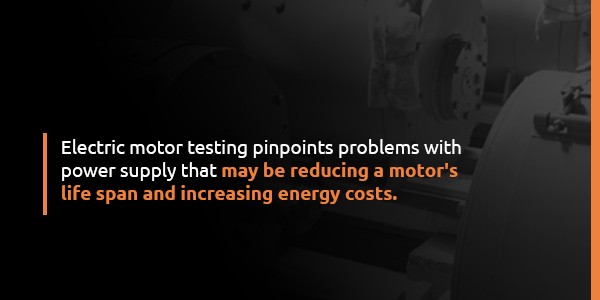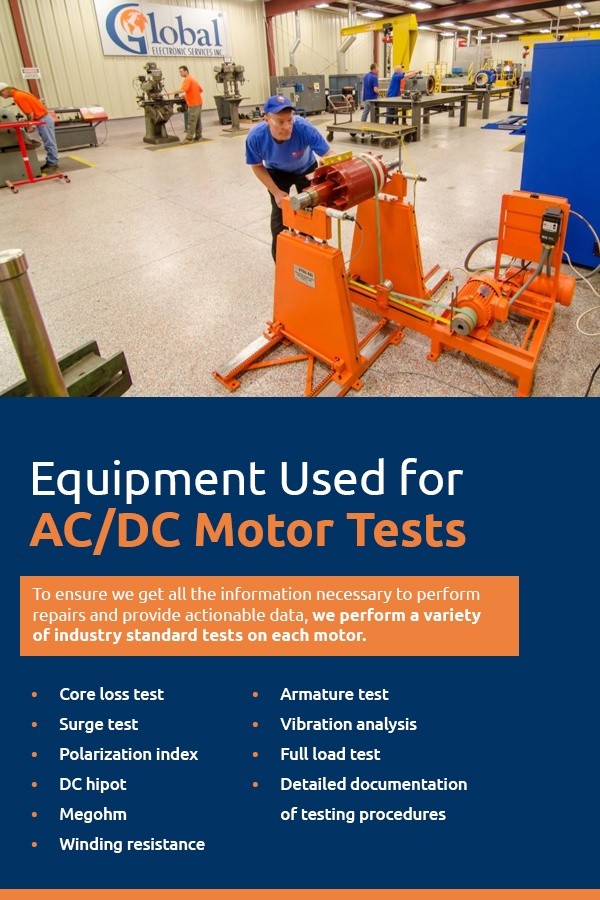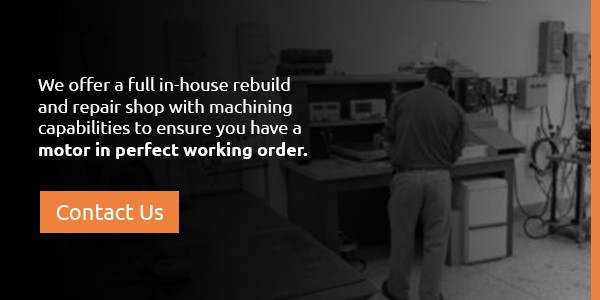AC/DC Testing Details
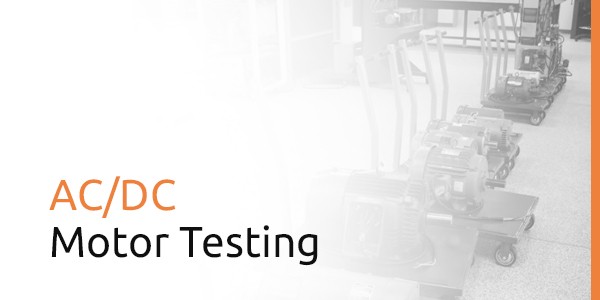
Global Electronic Services has excelled in the repairing and rebuilding of AC/DC motors for over a decade. We employ certified technicians and machinists of the highest skill and training. Quality repair, reliability and turnaround are our priority. When your company has a motor to be evaluated, tested or repaired, think Global Electronic Services.
AC/DC Motor Testing Services
Why is electric motor testing an essential service for your business? Here are four things AC/DC motor testing can do for your business.
1. Maximize Up-Time
Testing electric motors routinely allows your business to find out if a motor is defective before it actually fails. A crucial motor failing unexpectedly can cause serious damage to streamlined processes, so regular testing is essential for getting the most up-time out of any motor. This allows your business to create a plan for continuity ahead of time. Management can account for the time the motor will be out of service for repair, minimizing interruptions.
2. Save Money
Determining the true condition of a motor allows businesses to avoid unnecessary collateral damage and increased maintenance costs due to motor failure. Having to repair or replace a motor can be expensive, so having them tested allows for better financial planning. Testing will indicate the most appropriate action to take in terms of repair or replacement, saving money in the long run.
3. Conserve Energy
There are a variety of problems that can cause a motor to consume more power than it should. When these issues occur, other assets connected to the motor may experience premature and accelerated wear. Electric motor testing pinpoints problems with power supply that may be reducing a motor’s life span and increasing energy costs. Motor testing can also identify when a high-efficiency motor is not meeting its potential because of incorrect rewinding or core loss.
4. Improve Safety
Motor breakdown can result in unsafe conditions for those operating connected machinery. Motor testing can detect issues with electrical connections in a motor circuit, which can be missed when the motor undergoes infrared inspections. This reduces the possibility of electrical fires.
AC/DC Motor Testing and Repair Process
There are many types of motor testing used to identify issues. The two main motor testing methods are dynamic testing or static testing.
Dynamic Testing
Dynamic, or online testing, occurs while the motor is running. Technicians extract information on the quality of the motor’s power as well as its operating condition. The equipment in dynamic testing collects data, including:
- Voltage level
- Voltage imbalance
- Harmonic distortions
- Current level
- Current imbalance
- Load level
- Torque and rotor bar signatures
Static Testing
This type of motor test should be performed regularly, as it identifies problems with the unit’s components. Issues like broken rotor bars, air gaps between the stator and rotor, misalignments and end ring problems often show themselves during static testing. This testing method takes place while the motor is not running. To keep a motor running in optimal condition, both dynamic and static testing are recommended.
Testing Three-Phase Motors
Three-phase motors are the most common in industrial or commercial applications. The testing process for a three-phase motor includes both dynamic and static test methods, with a process that usually covers the following tests:
- Earth continuity and resistance: This test is conducted with a multimeter and determines the resistance between the ground and the motor body.
- Power supply: This test determines whether the motor is receiving the correct voltage.
- AC motor winding continuity: This test can indicate a burned out motor by checking the continuity of winding at each phase.
- AC motor winding resistance: This test checks whether the ohms reading for each winding is identical or almost identical.
- Insulation resistance: In this type of motor, resistance can be measured between motor windings or phases as well as in every motor phase and motor frame.
- Running amps: This test uncovers deviations from the motor’s rated full load amps.
The Global Electronic Service Process
When your company sends a motor in for testing or repair, there are five steps it goes through to ensure quality service:
- Initial receipt: Once we receive the motor, we log the unit in our system, giving it a unique bar code so you can track the process.
- Initial testing: We assign a technician to the motor to perform all AC/DC motor assessments required for the unit.
- Repair and re-testing: Should the unit require repair, we will send your company a quote based on the parts and labor required. Once the quote is approved, we complete the repair and run further tests to ensure the repair’s quality.
- Final prep: We take multiple steps to ensure the motor is ready to be put back in service with no extra steps for your company to get the unit up and running again.
- Quality assurance and shipping: After one last round of checks ensuring the motor is working as it should, we select the proper packaging, ship the unit and provide a detailed invoice accessible through our Secure Customer Portal.
Equipment Used for AC/DC Motor Tests
We feel that it is important to educate the customer about the proper testing equipment and procedures. Your company can contact us at any time to learn more about our methods and testing procedures or to learn the status of your DYNO electric motor testing and repair service order.
To ensure we get all the information necessary to perform repairs and provide actionable data, we perform a variety of industry standard tests on each motor. Testing services for electrical motors include:
- Core loss test: The core loss test reveals gaps between the input and output power of a motor. Technicians chart these deviations and compare them to industry standard levels.
- Surge test: This test will help identify failing conductor insulation and shorted turns in the motor conductor. These issues are early warnings of electrical failure.
- Polarization index: This index measures dirt and moisture buildup and insulation condition to determine whether they are appropriate for the motor to operate properly.
- DC hipot: The high potential, or “hipot” test is an electrical test that determines how effective motor insulation is. It is a way to quantify the motor’s capacity for safe operation under certain electrical conditions.
- Megohm: This test measures the motor winding’s insulation resistance to ground. The results quantify dirt, moisture and contamination on the windings.
- Winding resistance: This test can reveal multiple issues, including resistance balance between phases, incorrect wire gauge, incorrect turn count, shorts to ground and open windings. In some cases, it can also reveal shorted turns.
- Armature test: This test uncovers common issues with the motor armature, such as defects in the commutator bar, riser defects and shorted turns or coils in the armature circuit.
- Vibration analysis: This test measures the motor’s ability to safely withstand vibrations during operation.
- Full load test: This test measures the motor’s function at 100% of its operating capacity, ensuring it works when pushed to full output.
- Detailed documentation of testing procedures: We provide full documentation of all tests so you can see exactly how your company’s motor performed in each category.
These tests determine how well a motor is functioning and if it needs to be repaired. Even if the motor does not need repair, the results of testing will show how well the motor is working and give an indication of how long the unit will last.
Testing Equipment Available for AC/DC Electric Motor Testing Services
Problems with an electric motor such as failure to start, intermittent running, running hot or frequently tripping the overcurrent device can come from a range of sources. It could be the power supply, or a jam, binding or mismatch in the driven load, for example. Alternatively, there could be a fault with the motor itself like a winding failure or burnt wire.
Diagnosing issues and testing to find problems before they occur requires a full suite of electric motor testing equipment that can gather data from each component of the motor. The following is a list of the equipment Global Electronic Services uses during the motor testing process.
- Baker AWA IV: Supports all major tests in a single portable unit that includes surge, polarization index, DC highpot, megohm, and winding resistance.
- Phenix Core Loss Tester: Determines if the core has damage iron. The Core Loss Tester is performed prior to the windings being removed to determine the integrity of the core and then is tested once again after the windings are removed.
- Baker D12000: Tests the 3 surge wave patterns with amplitude and time base. This equipment also tests DC highpot voltage, DC highpot leakage current and insulation resistance.
- Entek IRD Analyzer and Balancer: Tests the machinery’s vibration, dynamic balancing, RPM, velocity pickups and magnetic bases.
- Dynamometer: Tests horsepower, torque and speed. By placing a controllable load on electric motors with various horsepower, the dynamometer can look at your power outputs in multiple scenarios and ensure your motor is running at its top available operational efficiency.
At Global Electronic Services, we use the highest quality, industry leading equipment to perform all testing services. This ensures the best accuracy and allows us to gather all relevant data on each motor we test.
Dynamometer Testing for Electric Motors
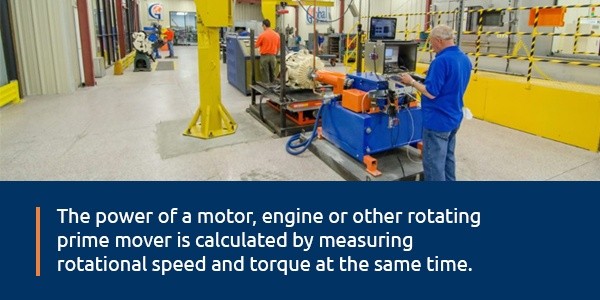
The dynamometer, frequently called a “dyno” is an essential tool for AC/DC motor testing. It measures power, force or moment of force. The power of a motor, engine performance or power of another rotating prime mover is calculated by measuring rotational speed and torque at the same time.
The dyno can also indicate how much torque and power are necessary to operate pumps and other driven machines. In these cases, the appropriate tool is a “driving” dynamometer. Dynos that are not designed to be driven are called “absorption” or “passive” dynamometers. Some dynos can absorb or drive depending on testing needs. These are called “universal” or “active” dynamometers.
Dynamometer Test Applications
Dynamometers do more than determining a tested machine’s torque and power characteristics. They are also used in a variety of other applications, such as standard emissions testing as regulated by the Environmental Protection Agency (EPA). In this case the dyno simulates road load for the engine alone or the full chassis to determine whether the vehicle’s emissions are acceptable according to current regulations.
AC motor dynamometers and DC motor dynamometers are key to the development and testing of electric motors. The dyno allows for variable and full load testing necessary to ensure optimal function.
One method used in electric motor dynamometer testing services involves applying water flow proportional to the load. This creates resistance to the motor. Then, water flows at a controlled rate through the dynamometer inlet manifold, aimed at the rotor of each absorption section. The system then employs centrifugal force to push water to the outer dynamometer body. As the water moves outward, it accelerates into the pockets of the strator plates. Then, the water is decelerated. Through a process of constant acceleration and deceleration, the dynamometer absorbs the power the motor produces. This exchange of energy heats and discharges the water.
Acquiring Data With Dyno Testing
The part of the dynamometer that gathers data is crucial to proper testing. The system usually has two components: a command unit and a workstation. The two components are linked by an Ethernet cable for fast information transfer. The commander is typically a desktop computer with a Windows operating system. The commander gives instructions to the workstation, which consists of a touch-screen device with an enclosure. The workstation does the actual operation and control systems. It collects data and sends it back to the command unit for processing, storage and analysis.
A workstation must be extremely precise to provide accurate data during AC/DC motor testing. It must be capable of measuring test data correctly, which requires properly calibrated pressure transducers. These measure the intake manifold’s air flow and the pressure of oil and other fluids.
Global Electronic Services electric motor testing procedure includes exhaustive dynamometer testing with a controllable load to test motor function under a wide range of power outputs. This is ideal for verifying optimal function on factory-direct equipment as well as rebuilt or repaired motors.
Turn to Global Electronic Services for Your Needs
Beyond DYNO electric motor testing services, Global Electronic Services is able to perform a broad set of work and testing on your company’s AC/DC motors. We offer a full in-house rebuild and repair shop with machining capabilities to ensure you have a motor in perfect working order.
A full testing facility also means we put your company’s motor through real-world testing, so it’s proven to be reliable and ready to be re-inserted into your operations. Everything we do is backed by an 18-month in-service warranty that exceeds the industry-standard 12-month option and covers all our parts and services.
On top of that promise, we’ll also beat any competitor’s price by 10% when you present us with a qualified bid. We’re that confident in our abilities to repair or build your motor and get it back to you that we also offer a standard repair time of one to five days with free one to two-day rush service available.
Give your company the cost-savings and efficiency maintenance it needs, plus have a team of qualified customer service representatives available to you 24/7 to discuss the status of your repairs and to provide any additional information you may require. You can also request a quote online for greater convenience.
